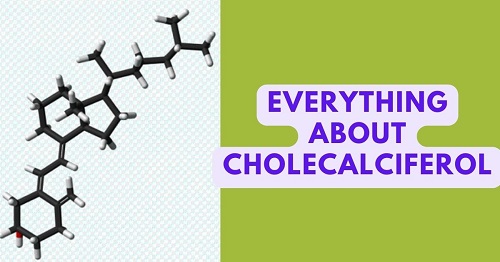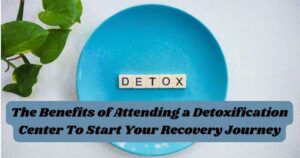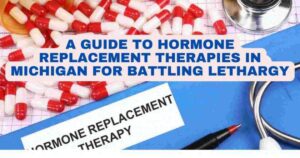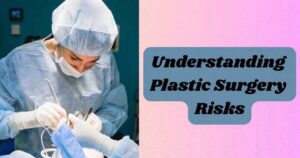Cholecalciferol (Vitamin D3) is the most common form of vitamin D, and it has many uses. For example, your body can use cholecalciferol to absorb calcium and phosphorus from food, thereby ensuring that your bones remain strong, your teeth remain healthy, and your blood pressure remains normal. But does cholecalciferol have side effects? According to experts in the field, there are no significant side effects associated with using cholecalciferol; however, you should speak with your doctor before using cholecalciferol to treat any health condition.

What is Cholecalciferol (vitamin D3)?
Cholecalciferol (also known as vitamin D3) is one of two forms of vitamin D. The other, ergocalciferol (vitamin D2), doesn’t provide all of cholecalciferol’s benefits, though some people are sensitive to both forms. Cholecalciferol plays a key role in helping your body absorb calcium, so a deficiency can cause brittle bones. It’s also essential to good health in other ways; according to one study, getting enough of it could help you live longer by protecting you from cardiovascular disease and cancer. And research suggests that taking too much may actually be beneficial—at least when it comes to preventing falls among older adults. Still, cholecalciferol isn’t something you should take without talking with your doctor first. Some people should avoid or limit their intake of it because they’re at risk for an overdose or toxicity.
Don’t take more than 1,000 IU per day without consulting your doctor first: In general, most doctors recommend that healthy adults get about 600 IU of cholecalciferol per day from food sources alone. If you’re not getting enough sunlight exposure or eating foods rich in vitamin D like fatty fish and fortified milk products, talk with your doctor about whether taking a supplement makes sense for you.
Benefits of Cholecalciferol/Vitamin D3
Used to help regulate calcium levels in bones, vitamin D3 has actually been linked to reducing calcium loss and maintaining bone density. Research has also found that a vitamin D deficiency can lead to musculoskeletal disorders such as osteoporosis, fibromyalgia, muscle weakness and pain. However, getting your daily dose of vitamin D3 will benefit more than just your bones; a recent study found that patients with heart failure who took 2000 IU of vitamin D3 per day lowered their risk of death by 18%.
Some additional benefits of including choline in your diet include an improved cardiovascular system and healthy cellular function. While any doctor will tell you taking cholecalciferol can greatly improve health, but what exactly are some cholecalciferol uses? In addition to treating or preventing conditions like rickets, certain cancers and multiple sclerosis, cholecalciferol can be taken orally or applied topically. In fact, doctors recommend applying sunscreen containing cholecalciferol before going outside during peak hours when UV rays are strongest.
Cholecalciferol is often added to over-the-counter sunscreens because it absorbs UV light in order to prevent damage from occurring on skin cells. Additionally, people who work outdoors may be at higher risk for developing cancer if they do not wear sunscreen containing vitamin D3 while working outside during peak hours of sunlight exposure.
What is Cholecalciferol made from?
Cholecalciferol is typically derived from lanolin, which comes from sheep’s wool. Because it’s hard to find natural sources of cholecalciferol, many companies rely on synthetic sources instead. Synthetic cholecalciferol is created through a process called irradiation, where ultraviolet light reacts with cholesterol to create cholecalciferol. This process creates only trace amounts of radiation and makes synthetic forms of cholecalciferol safe for consumption. It’s important to note that most foods don’t contain high enough concentrations of cholecalciferol for humans to reap its full benefits unless consumed in large quantities over time. It’s always best to speak with your doctor about adding supplements into your diet rather than consuming them without medical supervision.
Is Choline Calciferol addictive?
There are no records of addiction or withdrawal symptoms with vitamin D3 supplementation. It doesn’t seem to be addictive when taken in reasonable doses. You can use our dosage guidelines to figure out if you need more or less vitamin D3. However, since high levels of vitamin D3 can cause damage to your kidneys, make sure you don’t take too much. If you experience any adverse reactions while taking choline calciferol, stop using it immediately and consult a doctor. While there haven’t been any reports of people getting addicted to cholecalciferol, overuse could lead to toxicity.
Excessive consumption could also lead to complications like heart problems and kidney disease. Always remember that overdosing on supplements is dangerous and should be avoided at all costs. Taking higher amounts than recommended could cause various unpleasant side effects such as nausea, vomiting, weakness, dizziness, headache etc. It may also result in life-threatening conditions such as hypertension (high blood pressure), water retention and hypercalcemia (high calcium levels). So stick to recommended dosages at all times and do not exceed them under any circumstances!
Medical Uses for Cholecalciferol / Vitamin D3
In moderate doses, cholecalciferol can be ingested to help prevent rickets in children. In larger doses, cholecalciferol can be used as a treatment for psoriasis, which is an inflammatory skin condition caused by overactive immune cells. Vitamin D3 can also be prescribed as a treatment for high blood pressure (hypertension) and multiple sclerosis. According to research published in The Lancet medical journal in 2013, vitamin D3 supplements may also protect against cancer risk in postmenopausal women with low levels of vitamin D3 in their blood. And at least one study has found that people with low levels of vitamin D3 are more likely to suffer from depression.
People who want to take cholecalciferol for any reason should always consult with a doctor first. Doctors will typically recommend taking between 1,000 IU and 2,000 IU per day in order to obtain adequate amounts of vitamin D3 without experiencing adverse reactions or negative side effects. However, you should never exceed 10,000 IU per day without talking to your doctor first. You should also avoid taking cholecalciferol if you’re pregnant or breastfeeding, unless your doctor advises otherwise.
Side Effects from taking Cholecalciferol / vitamin D3
The use of cholecalciferol or vitamin D3 has become more popular lately, as studies show that low levels of vitamin D in our blood may lead to health issues. These include heart disease, Alzheimer’s disease, rickets and even muscle weakness. However, it’s also important to note that taking too much vitamin D can result in some negative symptoms including kidney stones and lethargy, so you should consult your doctor before beginning any treatment.
Additionally, because vitamin D3 comes from animal sources, vegans should be careful not to take too much. Those who are lactose intolerant may want to avoid taking supplements which contain small amounts of lactose, since they could cause an issue if large doses are consumed on a regular basis. If you are currently taking a supplement containing cholecalciferol or vitamin D3, make sure to read over all instructions carefully before consuming it and talk with your doctor if you have any questions.
Is Cholecalciferol harmful to humans?
Do not take cholecalciferol if you are pregnant, nursing, or under 18 years of age. Do not give cholecalciferol to other people, even if they have similar symptoms. Keep your medicine in a safe place where others cannot get to it. If someone accidentally swallows some of your cholecalciferol medicine, call a poison control center or go to the nearest hospital emergency room right away. Take care when driving, operating machinery, or performing other hazardous activities. Cholecalciferol may cause dizziness or drowsiness. If you experience dizziness or drowsiness, avoid these activities. Avoid drinking alcohol while taking cholecalciferol because alcohol can increase drowsiness caused by cholecalciferol.
Before using cholecalciferol, tell your doctor if you have liver disease; kidney disease; heart disease; diabetes; an electrolyte imbalance (such as low levels of potassium or magnesium in your blood); high blood pressure; thyroid problems (hyperthyroidism); low levels of calcium in your blood (hypocalcemia); osteoporosis; asthma or breathing problems; an allergy to fish oil or any part of cholecalciferol. Tell your doctor if you are pregnant before using cholecalciferol. It is not known whether cholecalciferol passes into breast milk or if it could harm a nursing baby. Do not use choline supplements without telling your doctor first.
What is Cholecalciferol made from?
Cholecalciferol comes from animal sources, so vegans may not want to take it. Like other forms of vitamin D, cholecalciferol can also come from sunlight. Cholecalciferol is better known as vitamin D3, one of two main types of vitamin D found in supplements. The other type is ergocalciferol, also known as vitamin D2. Sunlight and food are two sources of vitamin D; most Americans get all they need from sunlight during appropriate seasons. However, some people do not make enough on their own because they live in areas where there isn’t much sun year-round, or they don’t spend enough time outdoors during summer months when UV rays are strongest.
If you fall into that category, a supplement might be a good idea. If you prefer using a supplement rather than getting your vitamin D from sunlight, talk with your doctor about whether you should use an oral form of cholecalciferol or ergocalciferol. Both are equally effective at raising blood levels of vitamin D, but there are slight differences between them that could affect your health. For example, studies suggest that taking too much vitamin D (more than 2,000 IU per day) could increase your risk for kidney stones.
What is the difference between vitamin D and vitamin D3 cholecalciferol?
Most people wonder what difference there is between vitamin D and vitamin D3. The two forms of vitamin D are nearly identical in their effectiveness in raising blood levels of 25-hydroxyvitamin D (also called 25-OH or 25(OH)D), but they are not identical. Vitamin D2, also known as ergocalciferol, can be derived from irradiated yeast. However, most vitamin D2 supplements are made from irradiated fungi or lichen. Vitamin D3 (cholecalciferol) comes from animals’ skin after exposure to sunlight; therefore, almost all supplements sold over-the-counter as vitamin D are actually vitamin D3.
Both vitamin D2 and vitamin D3 convert to active form 1,25-dihydroxyvitamin D (1,25(OH)2D). In general, studies suggest that both forms of vitamin D produce similar increases in serum 25(OH)D concentrations when given at similar doses. There may be a few exceptions where one form has been shown to work better than another. For example, one study found that subjects who were given high doses of cholecalciferol had higher serum concentrations of 1,25(OH)2D than those who were given high doses of ergocalciferol.
How much cholecalciferol should I take?
The answer to how much cholecalciferol should I take depends on what you are taking it for. If you’re using cholecalciferol supplements to help manage your vitamin D levels, then a daily dose of 5,000 IU or more can be beneficial. If you are using a topical form (often applied directly onto your skin), such as a cream or lotion, then concentrations up to 10% can be absorbed well by your body if they’re applied properly. Side effects aren’t common with either method; however, if you experience an uncomfortable burning sensation in response to its application or ingestion, stop use immediately and speak with your healthcare provider.
There may be other causes for your discomfort than just an allergy to cholecalciferol. Also, make sure that you’re not consuming too much calcium at one time when supplementing with cholecalciferol granules because too much calcium can lead to kidney stones. In addition, remember that most multivitamins contain only 400 IU of cholecalciferol per serving, so it is important to check labels carefully before purchasing any supplement product containing vitamin D3. Too much supplemental vitamin D3 can cause hypervitaminosis D which leads to symptoms like nausea, vomiting, constipation and fatigue.
Is it OK to take vitamin D3 everyday?
Vitamin D3 comes in two forms, cholecalciferol (the kind you get from food) and ergocalciferol (the kind you get from supplements). It’s important to know that Vitamin D3 only comes in one type, though; so don’t worry if a supplement says Vitamin D2′′ on it. Also, do not take more than 4000 IU of Vitamin D3 per day. It can cause symptoms like headaches, nausea, vomiting and anorexia. If these symptoms persist or worsen, then stop taking your supplement immediately. The safe upper limit for adults aged 19-50 years old is 4,000 IU/day. You should also talk to your doctor before taking Vitamin D3 if you are pregnant or breastfeeding, as too much vitamin D can be harmful to both mother and baby.
You may need to have a blood test to check how much calcium and phosphorus are in your body before starting treatment with vitamin D3. This will help make sure you get enough calcium while avoiding excessive amounts of phosphorus. Do not take over-the-counter products containing vitamin D3 without talking to your doctor first as they may contain high levels of vitamin D which could be dangerous. Your doctor will want to monitor your progress regularly by measuring how much calcium is in your blood, although there’s no set schedule for doing so.








